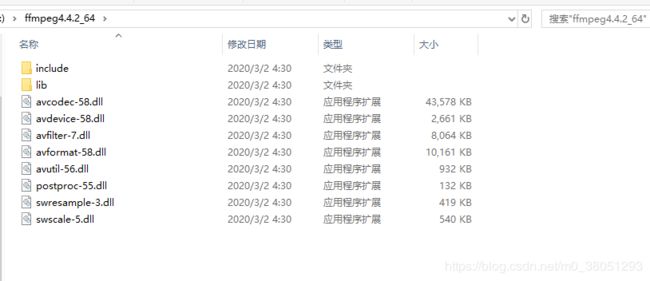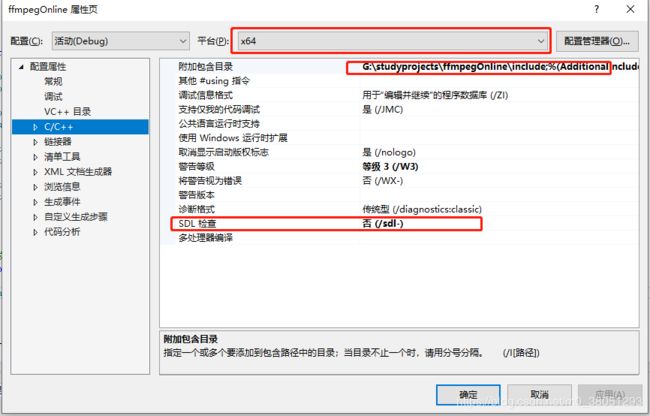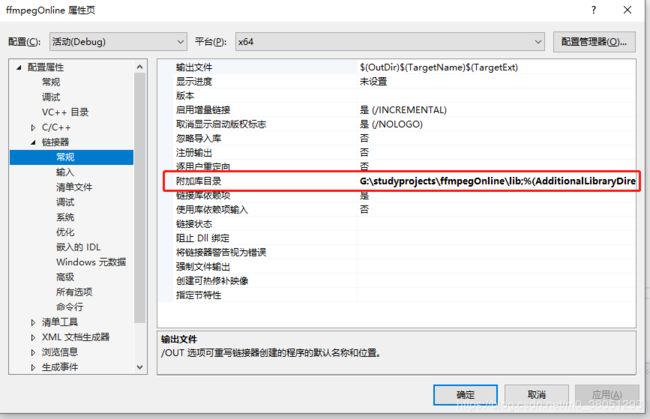FFmpeg入门教程:常见API使用及C语言开发
FFmpeg入门教程:常见API使用及C语言开发
- 相关概念理解
- 1、多媒体文件的基本概念
- 2、音频的量化编码
- 3、时间基
- 环境配置
- 相关下载
- 环境配置
- 测试
- 开发案例
- 处理逻辑及使用API
- 相关代码
- 参考文章
因为项目原因接触使用ffmpeg,当时是使用c#调用ffmpeg,通过指令对视频进行转码。指令的方式比较容易上手,但是如果涉及到复杂点的音视频二次开发,如果没有对音视频相关概念有一定的了解的话,感觉很难理解代码的含义和逻辑。由于兴趣最近开始摸索学习ffmpeg API的相关使用。
相关概念理解
1、多媒体文件的基本概念
- 多媒体文件就是一个容器
- 在容器中有很多流(Stream/Track)
- 每种流是由不同的编码器编码的
- 从流中读出的数据称为包
- 在一个包中包含着一个或多个帧
2、音频的量化编码
- 模拟信号到数字信号的转换过程(连续 ->离散、不连续的过程才能被计算机使用
- 模拟信号->采样->量化->编码->数字信号
- 量化的基本概念: 采样大小:一个采样用多少个bit存放,常用的是16bit
- 采样率:也就是采样频率(1秒采样次数),一般采样率有8kHz、16kHz、32kHz、44.1kHz、48kHz等,采样频率越高,声音的还原就越真实越自然,当然数据量就越大
- 声道数:为了播放声音时能够还原真实的声场,在录制声音时在前后左右几个不同的方位同时获取声音,每个方位的声音就是一个声道。声道数是声音录制时的音源数量或回放时相应的扬声器数量,有单声道、双声道、多声道
- 码率:也叫比特率,是指每秒传送的bit数。单位为 bps(Bit Per Second),比特率越高,每秒传送数据就越多,音质就越好。
码率计算公式:
码率 = 采样率 * 采样大小 * 声道数
比如采样率44.1kHz,采样大小为16bit,双声道PCM编码的WAV文件:
码率=44.1hHz*16bit*2=1411.2kbit/s。
录制1分钟的音乐的大小为(1411.2 * 1000 * 60) / 8 / 1024 / 1024 = 10.09M。
3、时间基
- time_base是用来度量时间的,比如time_base = {1,40},它的意思是将1秒分成40段,那么每段就是1/40秒,在FFmpeg中函数av_q2d(time_base)就是用来计算一段的时间的,计算结果就是1/40秒。比如一个视频中某一帧的pts是800,也就是说有800段,那么它表示多少秒呢,pts av_q2d(time_base)=800(1/40)=20s,也就是说要在第20秒的时候播放这一帧 时间基的转换。不同格式时间基的不同。
- PTS是渲染用的时间戳。DTS是解码时间戳。
音频的PTS:以AAC音频为例,一个AAC原始帧包含一段时间内1024个采样及相关数据,也就是说一帧有1024个样本,如果采样率为44.1kHz(1秒采集44100个样本),所以aac音频1秒有44100/1024帧,每一帧的持续时间是1024/44100秒,由此可以计算出每一帧的pts。 - 转换公式
timestamp(秒) = pts * av_q2d(st->time_base)//计算该帧在视频音频中的位置
time(秒) = st->duration * av_q2d(st->time_base)//计算视频音频中的长度
st 为AVStream流指针
时间基转换公式
timestamp(ffmpeg内部时间戳) = AV_TIME_BASE * time(秒)
time(秒) = AV_TIME_BASE_Q * timestamp(ffmpeg内部时间戳)//timestamp就算是PTS/DTS
环境配置
相关下载
进入官网 分别下载Dev和Shared压缩包。下载注意平台的选择对应。
将dev中include、lib文件分别解压到如下目录下。将shared中dll文件拷贝到项目Debug目录下,分则会出现报错。

环境配置
在VS中创建c/c++项目,右键项目属性


在其中添加如下dll文件
avcodec.lib; avformat.lib; avutil.lib; avdevice.lib; avfilter.lib; postproc.lib; swresample.lib; swscale.lib
libavcodec 提供一系列编码器的实现
libavformat 实现在流协议,容器格式及其IO访问
libavutil 包括了hash器、解码器和各种工具函数
libavfilter 提供了各种音视频过滤器
libavdevice 提供了访问捕获设备和回放设备的接口
libswresample 实现了混音和重采样
libswscale 实现了色彩转换和缩放功能
测试
本人是使用VS2017作为编辑器进行开发。
#include开发案例
实现对两组视频的视频音频混搭,一个类似小咖秀的功能。
处理逻辑及使用API
- API注册
- 创建输入、输出上下文
- 获取输入音频流、输入视频流
- 创建输出音频流、输出视频流
- 将输入流参数拷贝到输出流参数
- 判断文件大小,确定输出文件长度
- 写入头信息
- 初始化包、分别读取音视频数据并写入文件

相关代码
#include参考文章
音频基础知识
代码参考

